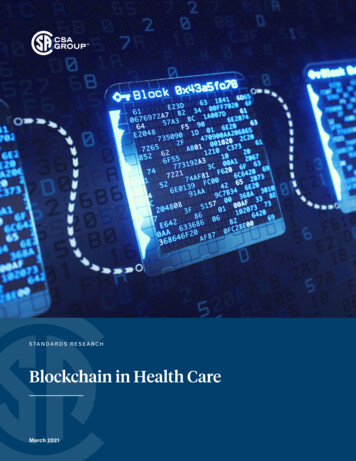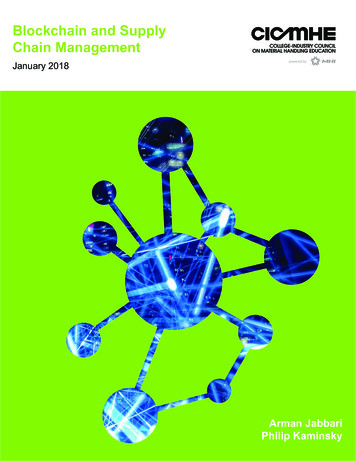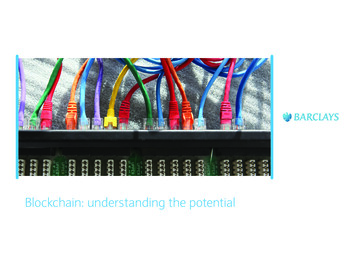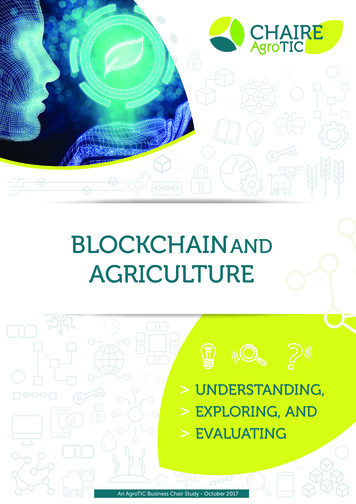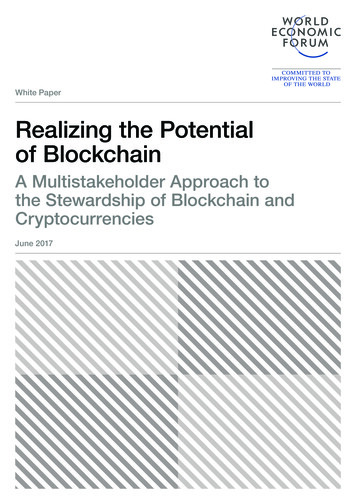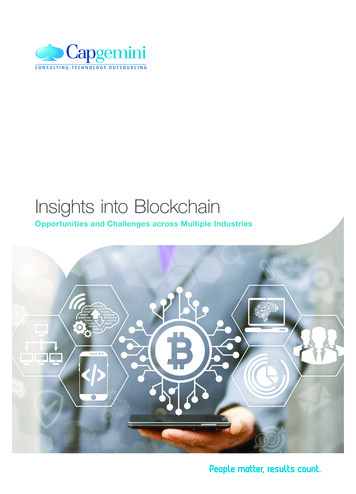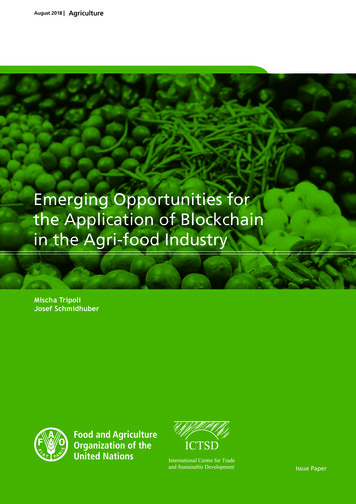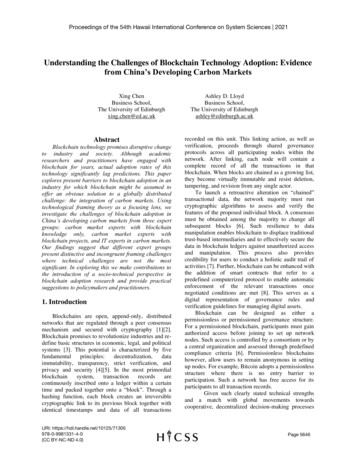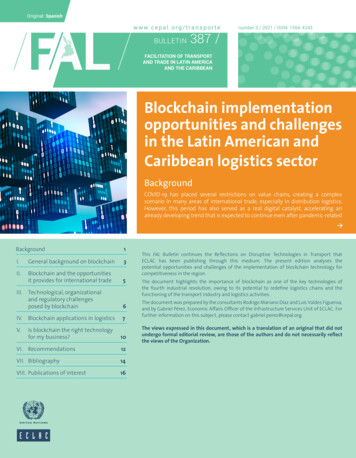
Transcription
Original: Spanishw w w. c e p a l . o r g / t r a n s p o r t eBULLETIN387number 3 / 2021 / ISSN: 1564-4243FACILITATION OF TRANSPORTAND TRADE IN LATIN AMERICAAND THE CARIBBEANBlockchain implementationopportunities and challengesin the Latin American andCaribbean logistics sectorBackgroundCOVID-19 has placed several restrictions on value chains, creating a complexscenario in many areas of international trade, especially in distribution logistics.However, this period has also served as a real digital catalyst, accelerating analready developing trend that is expected to continue even after pandemic-relatedBackground1I.General background on blockchain3II.Blockchain and the opportunitiesit provides for international trade5III. Technological, organizationaland regulatory challengesposed by blockchain6IV. Blockchain applications in logistics7V.Is blockchain the right technologyfor my business?10VI. Recommendations12VII. Bibliography14VIII. Publications of interest16This FAL Bulletin continues the Reflections on Disruptive Technologies in Transport thatECLAC has been publishing through this medium. The present edition analyses thepotential opportunities and challenges of the implementation of blockchain technology forcompetitiveness in the region.The document highlights the importance of blockchain as one of the key technologies ofthe fourth industrial revolution, owing to its potential to redefine logistics chains and thefunctioning of the transport industry and logistics activities.The document was prepared by the consultants Rodrigo Mariano Diaz and Luis Valdes Figueroa,and by Gabriel Pérez, Economic Affairs Officer of the Infrastructure Services Unit of ECLAC. Forfurther information on this subject, please contact gabriel.perez@cepal.org.The views expressed in this document, which is a translation of an original that did notundergo formal editorial review, are those of the authors and do not necessarily reflectthe views of the Organization.
w w w. c e p a l . o r g / t r a n s p o r t erestrictions are lifted, shaping a new logistical reality. The adoption of new technologies andthe innovation that this usually brings may also be a good alternative for the recovery from thiscrisis, through the creation of better quality jobs and safer and more efficient services.Society is in the midst of the fourth industrial revolution, characterized by a range of newtechnologies that are combining the physical and the digital, leading to paradigm shifts inall disciplines, economies and industries with even more dramatic impacts than previousrevolutions. In this new scenario, information is an organization’s greatest asset, andtogether with developments such as big data and machine learning, it not only has thepotential to allow organizations to significantly improve their efficiency and provide valueadded services that set them apart from competitors, but also to regenerate the naturalenvironment and undo the damage of previous industrial revolutions (Schwab, 2017).In trade and logistics specifically, the digital transformation is bringing about significantchanges in business models, with increasingly indistinct boundaries between both actorsand countries, and competition focused more on the quality of services than on prices(Barleta, Pérez and Sánchez, 2019). As highlighted in FAL Bulletin, No. 381, to address thisprocess, logistics governance must include coordinated actions that promote digitaltransformation and favour collaborative arrangements between the different actors ofthe logistics industry, both public and private, as well as the creation of technical-politicaladvisory bodies for this transformation process (Pérez and Valdés, 2020).According to the World Economic Forum (WEF), blockchain, which is one type of distributedledger technology (DLT), is one of the most promising technologies of the fourth industrialrevolution. This is because, regardless of the size of the logistics actor or its position withinthe value chain, there is a good chance that its processes or the data generated will soonuse this technology either directly or through applications that incorporate blockchaintechnology (WEF, 2019).The use of blockchain technology in logistics activities aims to reduce the handling ofpaper documentation, improve checks, reduce dispatch error rates and allow smartcontracts to be automatically executed when the conditions set by the parties are met.In addition, proper implementation of this technology is expected to substantially reducetrade disputes related to cross-border checks, making trade logistics operations simplerand cheaper (WEF, 2018).However, there are also significant technological challenges and difficulties in theimplementation of blockchain that could not only hinder the potential benefits of thistechnology (Pedersen, Risius and Beck, 2019), but could also exacerbate existing problemsrelating to areas such as free access to markets, integration of actors and asymmetries inthe treatment of small and medium-sized enterprises (SMEs).2FA L
The main issues of concern in the implementation of this technology are the complexityof implementation, the lack of trained professionals, processing times and cybersecurity(Knight, 2017). One problem to bear in mind is that, given the heterogeneity of existinginformation systems, as well as the big differences between implementing blockchainsthat are open and closed to a particular vendor, additional costs could be generated toachieve interoperability between systems, and this could have an impact especially onSMEs. The mass use of blockchain associated with a single technology provider could alsocreate entry barriers to certain markets or even strengthen the concentration of the sectorwith the resulting challenges this represents for free competition.This bulletin analyses the potential benefits and challenges of blockchain for Latin Americanand Caribbean countries and is divided into six sections. The first section presents aconceptual and theoretical background to the development of blockchain. Section twodescribes specific solutions that blockchain could provide in international trade. The thirdsection complements section two by analysing the current technological, organizationaland regulatory challenges of this technology. Section four analyses the main applicationsof blockchain in the logistics sector. Section five presents background information to helpactors in the port logistics industry decide whether to use blockchain technology based ontechnical and functional considerations. Finally, the sixth section of the document presentsrecommendations on blockchain for both public and private actors.I.General background on blockchainFrom a purely technical perspective, the term “blockchain” refers to a data structure thatstores information in blocks that form a chain in which new blocks are linked to previouslyformed blocks. The term was coined on 31 October 2008 by Satoshi Nakamoto, creator ofthe bitcoin cryptocurrency, in “Bitcoin: A Peer-to-Peer Electronic Cash System”. He explainedthat the purpose of blockchain technology was to create a digital version of cash thatcould be transferred between two entities without the need for the involvement of a thirdparty acting as an intermediary and attestor of the transaction (Nakamoto, 2008). Thiswas a radical change from the prevailing transactional model, in which a trusted thirdparty (typically a bank) was essential to validate the legitimacy of a transaction and theownership of the asset exchanged.Blockchain proposes a transactional model based on collective knowledge and trustbetween the participants themselves, without intermediaries, which allows them all toview the existing information and therefore give legitimacy to transactions and also tovalidate and then record the transactions.Each block is digitally signed by the owner and includes the relevant data of the transaction,a timestamp and the hash of the previous block, in order to link all the blocks that makeup the chain (Nakamoto, 2008). It is important to understand how the algorithm thatproduces the hash1 of each block works.Regardless of the data content (it can be one word or an encyclopedia), the algorithmapplies a mathematical function that transforms that content into a hash that is 256 bitsin length. This hash has two very important characteristics, namely, non-repetition (theprobability of finding the same fingerprint for different data is very low) and the uniquenessof the fingerprint, i.e., the result of applying the algorithm will always be the same eachtime the same data set is applied. If there is any change in the data, the algorithm outputwill change and therefore the fingerprint will be different, as shown in diagram 1.Bearing this in mind and considering that the hash of the preceding block is added to eachblock of data before calculation, the hash of the preceding block cannot change either,as it would change the result of the hash being calculated. Each block is thus linked tothe previous one. Running this iteration systematically over a period of time produces1The result, output or fingerprint of a set of data to which a given function is applied.3FA L
w w w. c e p a l . o r g / t r a n s p o r t econsecutively linked blocks identified by their ordinal number.To establish control of ownership of a digital asset and preventthe risk of double-spending, the date of the transaction is alsorecorded in each block to establish which transaction wasmade first.The operating model of a blockchain allows for theinvolvement of many participants, where each is able to storeand share information from the blocks in the network andis referred to as a node. These can all work at the same timewith little coordination and do not need to be identified, sincethe messages are not routed to any particular place. This givesrise to a distributed network without intermediaries thatcontrol it, which makes the model more solid. However, asthese blocks are replicated across different nodes, modifyinga completed block would, in theory, require applying thechange for all stakeholders across the network, which is whyblockchain data are usually considered secure and immutable(Brownworth, 2016).Diagram 1How a blockchain is builtOrdinal number of the blockOrdinal number of the blockOrdinal number of the ctionsTransactionsHash of the previous blockHash of the previous blockHash of the previous blockHash of the present blockHash of the present blockHash of the present blockSource: Prepared by the authors on the basis of A. Brownworth, “Blockchain 101: A Visual Demo”, Boston, MassachusettsInstitute of Technology (MIT), November 2016 [online] le the use of hash algorithms makes it extremely complicated for an attacker tochange the data, since they would have to control most of the processing power of thenetwork to overcome the accumulated capacity of the honest nodes, this is feasible whenthe nodes are limited or extremely vulnerable. The technical cybersecurity term applied tothis phenomenon is “Sybil attack” (Binance Academy, 2020).When every node in the chain can view the information freely, the blockchain is “open”.When nodes require authorization to read the blocks, the blockchain is “closed”. The nodesparticipating in a blockchain can read, write and commit transactions, depending on theirpermissions. Table 1 describes blockchains on the basis of permission models (Hileman andRauchs, 2017).4FA L
Table 1Types of blockchains based on permission modelsOpenClosedType of permissionReadWriteCommitPublic permissionlessAnyoneAnyoneAnyone (high computationalpower required)Public permissionedAnyoneAuthorizedparticipantsAll or subset ofauthorized izedparticipantsAll or subset ofauthorized participantsPrivate permissionedPrivateparticipantsNetworkoperator onlyNetwork operator onlySource: Prepared by the authors on the basis of G. Hileman and M. Rauchs, “Global Blockchain Benchmarking Study”,Cambridge Center for Alternative Finance, University of Cambridge, 2017 [online] LOBAL-BLOCKCHAIN.pdf.Finally, a consensus algorithm allows each member of a group to take and support adecision that favours everyone. Consensus is required to ensure equity and equality in theblockchain. The first algorithm used by the bitcoin network is called proof of work (PoW)and it involves solving a highly complex mathematical puzzle, which once solved, is veryeasy to reproduce in the rest of the nodes. While PoW is a very useful consensus algorithm,it requires significant computational power (hardware) to run in a reasonable amountof time, which makes it inconvenient in chains with high transaction rates and shorttransaction commit times. For this reason, a variety of consensus algorithms have beendeveloped to solve these issues, using mainly private networks, to reduce the complexityand thereby the computational power and time required (Ismail and Materwala, 2019).II.Blockchain and the opportunities it providesfor international tradeEach international trade operation triggers hundreds of processes and as they are carriedout, they are registered in the systems of each participant. Throughout the logistics chain,these data are replicated in the systems of each participant, where they are often reentered into a new system. In Latin America and the Caribbean, it is estimated that 75%of exporters re-enter data in their systems and then submit paper documentation to therespective trade authorities (IDB, 2020). The existence of multiple records often leads toerrors, information time lags, delays and inefficiencies, and may even lead to fraud.5FA L
w w w. c e p a l . o r g / t r a n s p o r t eGiven that the blockchain contains a single shared and verified version of the data, properimplementation of this technology can provide the same information to all participants,eliminating the need for a centralized authority and reducing the volume of paper used(paperless trade), time, costs and the complexities of bilateral trade communications.Moreover, if the storage of information in the blockchain involves advanced cryptographictechniques (blockchain data are by default not encrypted) in addition to encrypted electroniccommunication between the parties, much more secure services can be provided, allowingtraceability and analysis of data dynamics (Perboli, Musso, Rosano, 2018).The World Economic Forum developed a study on blockchain and its potential impacton supply chains, which involved more than 60 participants from 40 different countries.This analysis identified five generic blockchain use cases and their potential impact oninternational trade, as shown in table 2.Table 2Use cases relating to international trade and supply chainsUse casePotential impact of blockchainProduct provenanceand traceabilityStreamlining ofcommercial operationsIt would offer advantages and greater accuracy in the management of productcertificates, reducing the risks of fraud and adulteration.It would favour secure information-sharing, fostering secure and paperlesstrade. Traceability using this technology would favour better planningwithin processes.It would increase transaction efficiency, through faster processes and loweradministrative costs. When certain contract conditions are met, contracts areexecuted automatically.It would make trade finance easier and more transparent, especially in termsof efficiency and security of processes.It would encourage the auditing of processes and thus encourage businessesto be more transparent and ethical.Automation andsmart contractsTrade financeFacilitation of the detectionof discriminatory measuresSource: Prepared by the authors on the basis of World Economic Forum (WEF), “Inclusive Deployment of Blockchain forSupply Chains - Part 1 – Introduction”, White Paper, Geneva, March 2019.Among these cases, perhaps trade finance could have a more quantifiable and visibleimpact for regional exporters, especially for SMEs that must face the high costs associatedwith this item, both for the financial transaction itself, and for the time taken and possibledelays in the international banking process.Therefore, proper implementation of blockchain could improve the efficiency and security ofinternational trade. Some areas of trade in which this technology could bring about importantchanges are: achieving consensus and establishing international standards that allow theinteroperability of systems associated with certification of origin; and traceability of sensitivetrade data through blocks, starting with the genesis block —ensuring the immutability of dataand their purpose— through the use of a single shared ledger to determine the ownership ofan asset or the completion of a given transaction (Ahuja, Amir and Kunpeng, 2020).On the basis of these characteristics, it is hoped that the logistics sector business modelwill change soon, and incorporate new applications, technologies and value added services,allowing the satisfaction of demand that is much more challenging in terms of securityand traceability, and services with shorter delivery times and lower delivery costs.III.Technological, organizational and regulatorychallenges posed by blockchainLike any new technology, blockchain has gone through different stages of development.From the initial phase of exploration of possibilities, to the development of the structure andcontent, to a state of maturity in which the market helps to define its practical usefulness.Today blockchain has reached a stage of technological maturity and therefore developers arebeginning to strengthen its use to tackle new technological and organizational challenges.6FA L
Some of the main ones, for example, are the tendency towards excess in the applicability of thetechnology (everyone wants to use or says they want to use blockchain, although they do notreally need it); the shortage of technical professionals specialized in this technology,2 especiallyprofessionals who also know the logistics business; and last but not least, the high cost ofimplementing solutions, including not only hardware and storage capacity, but above all, theconsultancy services to create and subsequently support the applications that use blockchain.In order to quantify the IT resources required for blockchain, the bitcoin analogy will beused as a valid example owing to the related transactional volume, development time andexperience of use. The bitcoin cryptocurrency is not only highly developed, but the size ofthe complete bitcoin blockchain has grown exponentially, to 288GB in August 2020 andthen to 335GB by the end of March 2021, which means that each completed bitcoin blockrequires that amount of storage space at least in each node, and in June 2020 the totalnumber of nodes was roughly 45,000 (Blockchain.com, 2020).Another factor that helps to measure the demand for equipment is the IT processingtime to generate new blockchain blocks. For example, another cryptocurrency that usesblockchain is ethereum, which doubled in size in 2020, with the size of an archive node—which stores the complete chain, the state of transactions and blocks completed sinceinception— amounting to five terabytes.3With regard to organization, blockchain eliminates intermediaries, thereby causingparadigm shifts in some of the rules of business and traditional organizational cultures(Pawczuk, 2020) through the decentralization and democratization of information(Baldet, 2019). The use of multiparty models in organizations where peer-to-peer (P2P)communication was infrequent can lead to major paradigm shifts in areas ranging fromthe ownership and privacy of internal data to the analysis of the impact of these changesin terms of possible civil or criminal liabilities (Pawczuk, 2020). These elements are alreadybeing analysed by entities such as the World Economic Forum and the CommunityResearch and Development Information Service (CORDIS) of the European Union.As organizations adapt their models to the new structure, governments and internationalregulatory frameworks must also adapt their technical rules and regulations to the newdigital context. One issue, undoubtedly among the most important, is information security.Confidentiality, integrity and availability (the CIA triad) represent the basic principles ofinformation security (CambioDigital, 2020). Although blockchain design includes elementsassociated with the integrity and availability of data, as mentioned earlier in this document,confidentiality (security) is not an intrinsic characteristic, despite the erroneous myth thatblockchain data are secure because they are encrypted. It is important to bear in mindthat blockchain data are not encrypted by default, but are available to all participants,and cryptography is used only to generate records immutably over time or in specificapplications. For this reason, the security triad must be incorporated into blockchaintechnology as one of the specific functional requirements for both decision-making andthe implementation of solutions.IV.Blockchain applications in logisticsAs discussed previously, some specific characteristics of blockchain make it an interestingtechnology to improve the confidentiality, integrity and availability of commercialinformation and of logistics processes, favouring cooperation between dispersed actors.Moreover, by dispensing with a central authority, and provided that the information isencrypted and replicated in the nodes of the participants, blockchain could favour technicalsolutions that promote transparency, auditability and functional equity of transactions(Tsiulin and others, 2020).23Only 56% of the world’s top 50 universities offer courses on blockchain (Coinbase, 2019).One terabyte (TB) is equivalent to one million megabytes (MB) or 1,000 gigabytes (GB), which is equivalent to the disk storagecapacity of approximately four modern laptop computers (256 GB).7FA L
w w w. c e p a l . o r g / t r a n s p o r t eThese potentialities have prompted blockchain developments and initiatives orientedespecially to the logistics sector, such as CargoX, TradeLens, CargoSmart, dexFreight,CADENA and others, which aim to create digital solutions for cargo document management,traceability of certificates of origin of products, trade finance, leveraging of the Internet ofThings (IoT) and contract automation, among other applications that are being developedand that are expected to be launched soon.In 2016, the Linux Foundation established Hyperledger, an open source communityfocused on developing a suite of stable frameworks, tools and libraries for enterprise-gradeblockchain deployments. It is a global collaboration involving the finance, banking, supplychain, manufacturing and technology sectors (Hyperledger.org, 2020a). Under this scheme,supported by the Linux operating system, tools and methodologies have been developedto manage the confidentiality of the data stored on the blockchain. Particularly noteworthyis the channel approach, whereby nodes can only access information in the channels towhich they belong or to which they have been authorized access. Diagram 2 illustrates thisarchitecture and the distribution of the blocks only in the nodes belonging to the samechannel, thus protecting the confidentiality of the information from other nodes outsidethe channel.Diagram 2How channels operate in HyperledgerNode 1Organization 1Node 2Organization 2Node 3Organization 3Global channelChannels 1 - 2Channels 1 - 3Source: Prepared by the authors on the basis of the Hyperledger Fabric model.In 2016, Walmart used the Hyperledger platform to develop a proof of concept project toanalyse the benefit of food traceability technology in possible outbreaks of food-bornediseases. It took weeks to find the source using the “traditional” means of detecting andisolating potentially contaminated batches, while the use of blockchain allowed this to bedone in a matter of minutes depending on the number of nodes and the complexity ofthe product value chain in terms of intermediaries (Hyperledger.org, 2020b). Similarly, inDecember 2019, KPMG, Merck, Walmart and IBM conducted a pilot programme on systemsinteroperability using blockchain technology to establish supply chain traceability forsome prescription drugs regulated by the United States Food and Drug Administration(FDA). The programme met the expected reporting and traceability requirements andreduced the tracing time from 16 weeks to 2 seconds (Treshock, 2020).Table 3 details the main blockchain solutions associated with international logistics andtransport currently in use and the type of blockchain they employ.8FA L
Table 3Features of blockchain solutions related to maritime and port logisticsSolutionCargoregistration TraceabilityTradefinanceInternet of things andautomation supportType of teXPublic permissionedDataPortsXDexfreightXXCadenaXPublic permissionedCargoXXPublic permissionedWave BLXPublic permissionedCargochainXPublic permissionedChain of ThingsXGatechainXOpen Trade DocsXProvenanceSkuchainXPublicPublic permissionedXXXPublicPublicXPublicSource: Prepared by the authors.The following sections will analyse three initiatives that are relevant both in terms of theirmass use and regional approach.A. TradeLensOne of the projects that is currently furthest along in terms of maturity is TradeLens, asolution developed by A. P. Moller-Maersk and IBM in 2018. It is an operational platformused by groups in the global shipping network, employing a cloud-native approach withan application programming interface (API) that enables the exchange of electronicdocuments in the standard format defined by the United Nations Centre for TradeFacilitation and Electronic Business (UN/CEFAT). The platform uses microservices, whichin turn use and send data to a lower layer of storage comprising various persistencetechnologies, such as object storage, document databases, relational databases and somedata stored in blockchains. Although the reference to TradeLens here is directly related tothe use of blockchain, the platform only stores some data using this technology. The restare stored using different technologies depending on the nature of the information to besafeguarded and may not reflect the characteristics of blockchains.The information stored in the blockchain is incorporated in a chain for each shipping line,and each chain is called a channel, in keeping with the Hyperledger Fabric standard. The datain one channel are not visible to the others (TradeLens, 2020). In other words, each shippingcompany vertically builds its channel in the data storage layer as an individual blockchain.While the standard used by TradeLens is open source, participating nodes must beestablished within the IBM Blockchain Platform, a private cloud-based blockchain platformoffered by IBM with permissions for access to information. This implies that all nodesbelonging to a channel, or to the entire trade and logistics ecosystem involved, must beincorporated into the service platform of a single private company, which means that thetheoretical concept of trust is not fulfilled as there is one blockchain network operator.B. DataPortsDataPorts is a system funded by the European Union and aims to provide advanced dataservices using artificial intelligence techniques for the next generation of cognitive ports.9FA L
w w w. c e p a l . o r g / t r a n s p o r t eIt involves public and academic institutions from France, Germany, Greece, Israel and Spain,collaborating under the Horizon 2020 project of the Digital Agenda for Europe initiative(CORDIS, 2020). The project seeks to change the paradigm of collaboration with a focus oncoordinated efforts in the regulatory and normative framework.The consortium promises to interlink information from multiple data sources such as globalshipping networks, port community systems (PCSs) and logistics operators. HyperledgerFabric has been selected as the blockchain distributed storage platform because it bestsuits the context of the port community (DataPorts 2020). In this case, unlike in the previousexample, the blockchain will be public, but access to global information, specifically relatingto ports, will be restricted. Work is also being done to establish policies to exchange andtrade data in an accurate, secure and reliable manner. The pilot test of this project involvesthe Port of Valencia and its PCS and the Thessaloniki Port Authority (THPA) for operationsinvolving cruise ship passengers and containerized cargo.Specifically, the aim is to observe the performance of blockchain technology in definingsecure rules for the exchange of data to ensure privacy and security, and in the improvementand efficiency of services provided relating to the supply chain and passenger transport(Safety4Sea, 2020).C. LACChain – CADENAThis initiative aims to develop an open ecosystem for the development of blockchainsolutions in Latin America and the Caribbean, independent of the technology used, topromote greater regional interoperability and to encourage public-private collaboration inthe exchange of cross-border data.Within this framework, a proof of concept called CADENA has been in development sinceFebruary 2018. It seeks to facilitate the exchange of data between several customs officesin Latin America on companies that are part of the regional authorized economic operator(AEO) programme. It is being developed by IDB and Microsoft, with the participation of theChilean National Customs Department, the National Directorate of Taxes and Customs ofColombia, the General Customs Directorate of Costa Rica, the Tax Administration Serviceof Mexico and the National Superintendency of Customs and Tax Administration ofPeru. Under this scheme in
potential opportunities and challenges of the implementation of blockchain technology for competitiveness in the region. The document highlights the importance of blockchain as one of the key technologies of the

